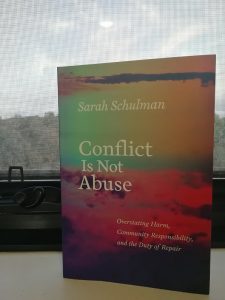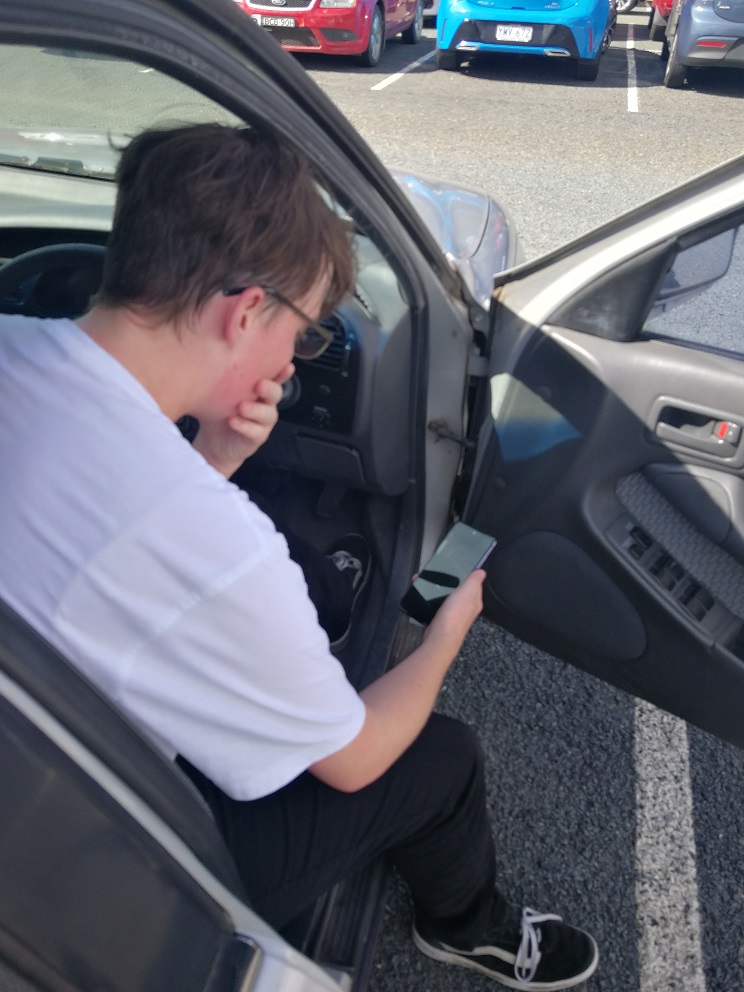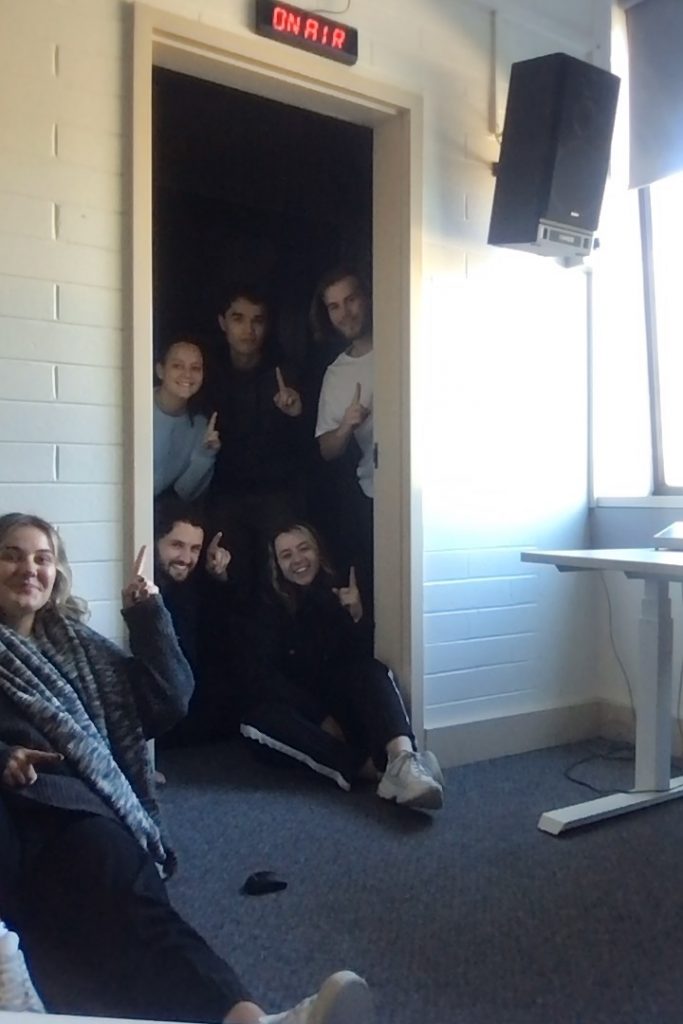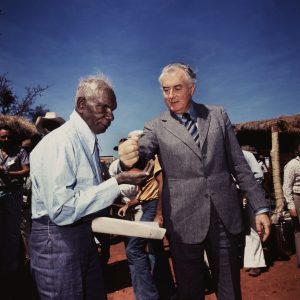More insightful than inciteful — Review of Sarah Schulman’s ‘Conflict Is Not Abuse’
Sarah Schulman knows you won’t agree with her — at least not on everything. In the introduction to her 2016 book, Conflict Is Not Abuse, Schulman encourages the reader to “read this book the way you would watch a play: not to emerge saying, ‘the play is right!’ but rather [to engage with the play’s ideas.]” She even goes so far as to say “this is not a book to be agreed with.” It is her sincere wish that the reader approaches the book critically and interactively, rather than accepting what she says without interrogating the idea.
And it’s a good thing she does, because Conflict Is Not Abuse spends its almost three-hundred pages grappling with some of the most controversial and fraught ideas in contemporary discourse.
Schulman structures her book by introducing her central thesis — “that at many levels of human interaction there is the opportunity to conflate discomfort with threat, to mistake an internal anxiety for exterior danger, and in turn to escalate rather than resolve”. She spends each chapter building upon it — exploring how and why this happens, and what we can do about it.
Conflict or Abuse?
In differentiating between Conflict and Abuse, Schulman builds upon a framework from social worker Catherine Hodges: “Abuse is Power Over and Conflict is Power Struggle.” It’s this definition that Schulman uses for her argument; Abuse can only be done to us, but Conflict is something multiple parties contribute to.
She’s quick to acknowledge that Abuse does exist, and in all levels of our society. For example, a Black man unjustly pulled over by the police is Abused by the State. However, she points out that the book isn’t about situations of actual Abuse, but rather situations where Conflict has been confused for it.
She argues this confusion occurs at all levels of our lives. We might feel uncomfortable with somebody, and confuse that for being materially harmed by them — just as the White Supremacist State paints Black people as “predators” in order to justify their mass incarceration.
According to Schulman, we “Escalate” normative Conflict to Abuse from one of two positions: Supremacy or Trauma.
Both of these, she argues, are hostile to information that challenges our sense of self, and intolerant of difference in others. The key difference is that in Supremacy this is from entitlement, whereas in Trauma it comes from anxiety.
Supremacy, social systems of privilege and dominance, refuses information that affects our idealised conception of ourselves. For example, white people aren’t expected to have slave-owning ancestors, whereas Black Americans are expected to have enslaved ones. Supremacy conceals the history of white oppressors, making slavery “something that was done to Black people by no one”.
When this obstruction is removed, people can react with shame, or lash out. Ben Affleck, as part of the PBS program Finding Your Roots, discovered his ancestors owned slaves. He pressured the network to remove this section from their broadcast, and they relented.
Conversely, Schulman sees Trauma as denying information to protect a fragile self. It’s initially hard to accept. I believe our society has, for a long time, stigmatised and mistreated those with trauma and associated mental illness. While Schulman is empathetic in dealing with this sensitive subject, it’s easy to have a knee-jerk reaction, since reasoned and considered discussion around this subject is so rare. However, Schulman manages to deliver just that.
Why Escalation occurs.
The book asserts that our society lacks empathy, which is only freely given when someone is a victim. Those who present themselves as flawed perpetrators of Conflict risk being shunned. Instead, they must become what Schulman calls “the Ethical Virgin” — somebody who has never done something wrong, never contributed to a fraught situation, and is a victim of the other party. She argues for a society where empathy is given freely. Being a part of Conflict is still an emotionally damaging experience, and Schulman wants a norm in which we support each other regardless.
Schulman always warns against thinking that misrepresenting yourself as a victim is a conscious choice, saying: “people who describe themselves as ‘Abused’ when they are actually in Conflict are not lying; they usually don’t know the difference”.
In Chapter Seven, Schulman examines four approaches to understanding Trauma, and finds they all agree that past pain can be projected onto the present. This is not a reason to shun those with trauma, but rather to understand how they feel and help them understand who they’re actually angry at — often, somebody far in the past. Though, this chapter would’ve been better earlier, as the assertion that those with trauma can lash out is integral to her argument and needs to be established.
Bad Groups and Communication
The question, then, is what can we do about it?
Here, Schulman argues that we have a responsibility as a community. When we see these situations, we cannot stand by and allow them to play out. We must step in, encourage people to sit down with each other, and create the conditions for repair.
The most dangerous thing is a “Bad Group,” which supports an enforcer rather than challenging their impulse. To Schulman, bad friends are ones who encourage us to immediately cut someone off and withhold communication. A good friend, on the other hand, asks us what the other person would say happened, and makes us see things from another perspective.

It is when talking about communication that Schulman is her most controversial. She says, explicitly, that “no one is obligated to obey a unidirectional order that has not been discussed,” in reference to someone saying, “don’t contact me.”
We are increasingly told that we have the right to determine the terms by which people talk to us. ‘Nobody is entitled to our time’, and so on. While the reader may initially disagree with such a bold statement as Schulman’s, she flips the framework on its head by asserting that this is not a case of anybody being entitled to our time, but rather we have a responsibility to communicate and negotiate.
The most convincing line on this subject is a simple assertion: “It is unreasonable to expect other people to interpret our silences.”
Conclusion
Conflict Is Not Abuse could have easily been a different book. It could easily have been a victim-blaming travesty. It could have failed to understand why people escalate, and painted them as inherently bad people. It could have been a book without empathy.
But it isn’t.
Conflict Is Not Abuse holds space for the accuser and the accused. Schulman encourages us to be open and critical, to love our friends and check their impulses; to never blame or shun them for mistakes, but to forgive them. In arguing this, she is eloquent and reasoned, if at times provocative.
I’d like to give the final word to Schulman, who writes about how we should treat those who confuse Conflict for Abuse:
“Wouldn’t it be amazing[…]if we could turn to our friends and say, ‘I felt anxious and so I exaggerated,’ and instead of them using that as a reason to ignore us, disparage us, or punish us, whenever we say I feel anxious and so I exaggerated, our friends would put their arms around us, hug us and kiss us and thank us and praise us for telling the truth?”


Be the first to comment!